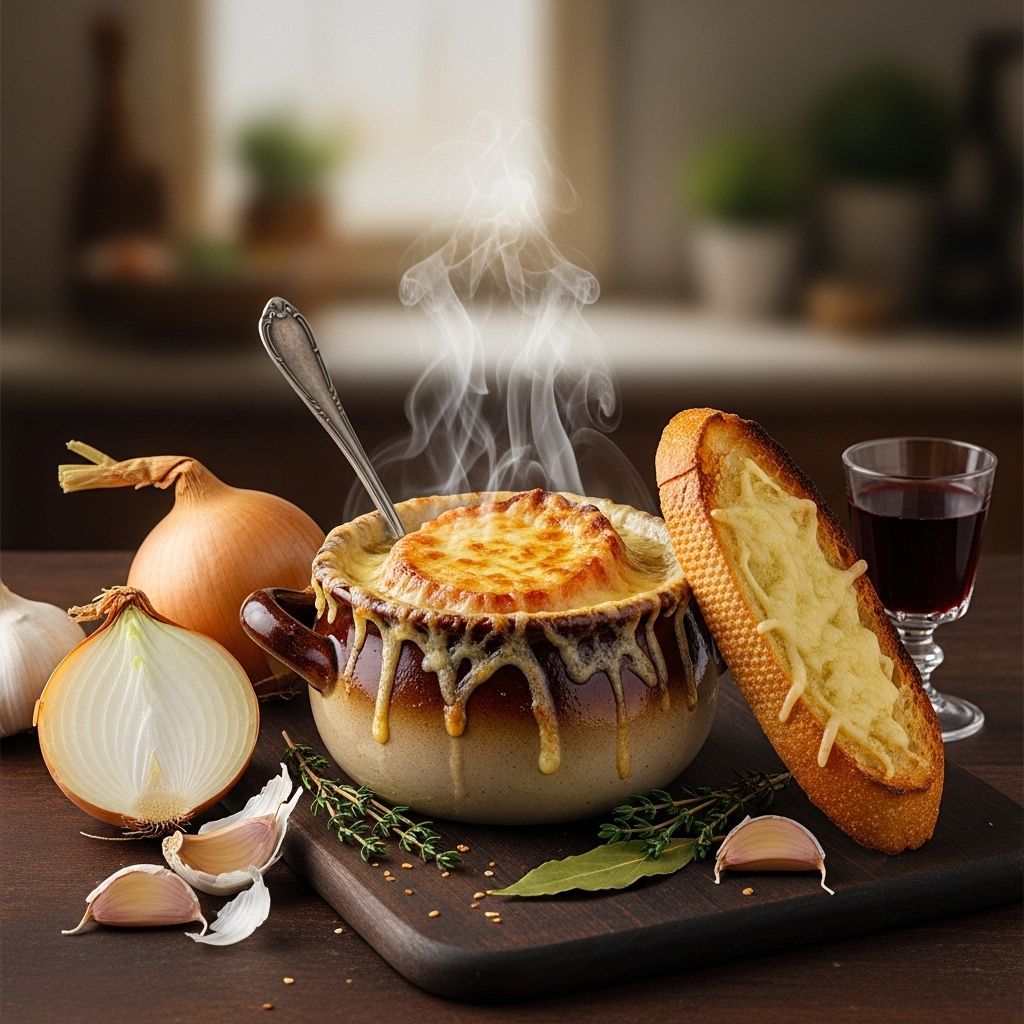Mastering the Art of French Onion Soup: Technique, Depth, and Tradition
Turn simple ingredients into a savory, cheese-laden dish that soothes and satisfies.

Mastering French Onion Soup: A Deep Dive Into Technique and Tradition
Few dishes better embody the spirit of rustic French cooking than French onion soup. Although its roster of ingredients is humble—primarily onions, broth, and bread—the technique required to elevate these basics into a thoroughly satisfying, comforting bowl is anything but simple. This article walks through every stage: choosing the onions, proper caramelization, selecting the best stock, layering flavors, and achieving the perfect gratinéed topping.
The Core Components of French Onion Soup
At its heart, French onion soup rests on two critical components:
- Caramelized onions: The flavor backbone, responsible for the soup’s natural sweetness and depth.
- Broth: Provides the soup’s body, richness, and savory undertones.
When executed correctly, the result is a harmonious balance of sweet onions, savory liquid, and a golden cheese crust over crisp bread.
Choosing the Right Onion Varieties
One of the most common questions is what type of onions to use. While yellow onions are standard and reliable, experts agree that a blend yields more complex results. The nuanced flavors from mixing yellow, sweet, and red onions offer sweet, savory, tangy, and aromatic notes.
- Use a mix of onion varieties for balanced, multipronged flavor.
- Yellow onions provide a classic, robust taste.
- Sweet onions add subtle depth and overt sweetness.
- Red onions inject a hint of bite and aromatic character.
Tip: Prepare enough onions. Remember, the slow caramelization process will reduce their volume significantly.
The Art and Science of Caramelization
Crisp, sweet, deeply bronzed onions are the soul of French onion soup. While recipes and opinions vary, authentic technique draws from classic French kitchens—think Jacques Pépin, Julia Child, and André Soltner—who emphasize slow and moderate caramelization rather than a rapid, deep charring.
- Caramelize onions over medium-low heat, stirring frequently.
- Avoid rushing the process; expect up to 1–2 hours for optimal results.
- Don’t over-darken onions. Extremely dark onions can become bitter or acrid, diluting the delicate sweetness.
- Caramelization stops when onions achieve a rich, golden-brown hue with a soft, jammy texture.
During caramelization, natural sugars convert into rich, complex flavors, lending the soup its iconic taste. Recognize that patience is essential—the difference between flavorful sweetness and burnt bitterness lies in careful, attentive heat management.
Deglazing and Layering Flavors
Once onions reach the proper level of caramelization, it’s time to build more flavor with a thoughtful deglaze. Classic French recipes suggest using a splash of sherry, white wine, or dry vermouth:
- Deglazing lifts flavorful browned bits from the pan, incorporating nutty, wine-like aromas into the soup.
- Sherry is favored for its subtle complexity, blending seamlessly with sweet onions and savory broth.
Broth Selection: Classic vs. Modern Approaches
Traditionally, French onion soup utilizes homemade beef stock—robust, rich, and deeply meaty. However, the realities of home cooking mean few have beef stock on hand. Many experts recommend high-quality chicken stock as a versatile alternative:
| Type of Stock | Flavor Profile | Best Use | Accessibility |
|---|---|---|---|
| Homemade Beef Stock | Deep, rich, intensely savory | Traditional French onion soup | May require advanced preparation |
| Homemade Chicken Stock | Mild, meaty, adaptable | Everyday French onion soup | Commonly available, quick to make |
| Store-bought Stock | Varies—often mild, may lack depth | Convenient, but select high-quality brands | Readily available |
If possible, prepare your own stock for better depth and balance. But even commercially available chicken stock can produce robust, satisfying results when combined with well-caramelized onions.
Seasoning and Balancing the Soup
Salt, freshly ground black pepper, and sprigs of thyme bring classic French aromatics. Bay leaf and a hint of garlic are optional but popular additions. Remember:
- Season judiciously; the saltiness of ingredients like stock and cheese will intensify as the soup reduces.
- Taste frequently as the soup simmers to adjust flavors and avoid overseasoning.
The Bread and Its Role: Texture and Tradition
No French onion soup is complete without the classic topping of crispy bread and bubbling melted cheese. The bread should:
- Be thickly sliced, ideally from a rustic baguette or country loaf.
- Toasted or dried slightly before use to prevent sogginess.
- Cover the surface of the soup, acting as a raft for the molten cheese.
The bread not only adds heartiness but also absorbs the flavorful broth, enriching the eating experience with every bite.
Cheese for Gratinée: Choosing and Melting
Gruyère is the cheese of choice for traditional French onion soup, prized for its melting qualities, nutty aroma, and golden color. Some recipes blend Gruyère with Emmental or Swiss cheese for more stretch and tang. Tips for perfect gratinée:
- Grate cheese finely so it melts evenly over bread.
- Use generous amounts for a thick, golden cap.
- Broil until bubbling and crisply browned, but not burnt.
The result: a stunning visual and sensory finish—golden, earthy, and addictively stretchy with every spoonful.
Step-by-Step: Making Authentic French Onion Soup
- Prepare onions: Peel and thinly slice 2–3 pounds of mixed onions.
- Caramelize: Cook onions slowly in butter and a touch of oil over medium-low heat, stirring regularly, until deeply golden and jammy (process takes 1–2 hours).
- Deglaze: Add a splash of dry sherry or white wine. Stir and scrape up any browned bits.
- Simmer in stock: Pour in beef or chicken stock (about 6 cups), add aromatics, and let simmer for 30–45 minutes. Season to taste.
- Prepare bread: Slice baguette; toast slices until crisp.
- Gratinée: Ladle hot soup into oven-safe bowls. Top each with toasted bread and a generous mound of grated Gruyère cheese. Broil until cheese is bubbly and golden brown.
Expert Tips and Common Mistakes
- Don’t rush caramelization—gentle, steady heat is key.
- Don’t overbrown onions: you want sweet, rich, and mellow, not sharp or bitter.
- Use quality stock, preferably homemade or a trusted brand with no artificial flavors.
- Adjust seasoning gradually; the cheese and broth contribute saltiness.
- Choose bread that is sturdy and slightly stale—it holds up best through broiling.
- Don’t skimp on cheese: the gratinée should be thick and fully cover the bread.
Nutritional Profile and Variations
Traditional French onion soup is remarkably satisfying, but fairly rich due to the toasted bread and melted cheese. For lighter or allergen-friendly options, consider:
- Substituting chicken stock for lower fat.
- Using gluten-free bread if needed.
- Choosing a lighter cheese blend for reduced calories.
Vegetarian adaptations omit beef stock in favor of robust vegetable stock and may incorporate soy sauce or mushroom stock for extra depth.
Frequently Asked Questions (FAQs)
Q: Can I use only yellow onions?
A: Yes, yellow onions are traditional and work well, but mixing varieties improves flavor complexity and depth.
Q: How do I prevent onions from burning during caramelization?
A: Use a heavy-bottomed pot, moderate heat, and stir frequently. If onions stick, add a splash of water to loosen and continue cooking.
Q: What if I don’t have oven-safe bowls?
A: Assemble bread and cheese separately on a baking sheet, broil until melted, then transfer to bowls of hot soup.
Q: Where does French onion soup come from?
A: It’s rooted in traditional French bistros and home kitchens, with a long history dating back to the 18th century and Parisian markets.
Q: Can I make French onion soup ahead of time?
A: Yes! Caramelized onions and stock base can be prepared and refrigerated for up to three days. Assemble and broil with bread and cheese just before serving.
Serving Suggestions
Classic French onion soup is usually enjoyed as a hearty main course on cold days, often paired with:
- Crisp salad with vinaigrette for balance
- Light, dry red wine or French cider
- Simple roasted meats or vegetables
It’s perfect served straight from the broiler, bubbling hot, with extra bread on the side.
Conclusion: French Onion Soup, A Culinary Icon
French onion soup exemplifies the beauty of transforming humble ingredients with time and technique. The balance of sweet, savory, crusty, and gooey appeals to every sense. By mastering onion caramelization, choosing the right stock, layering flavors, and finishing with an irresistible gratinée, you’ll unlock the magic of French tradition in your home kitchen.
References
Read full bio of Shinta












